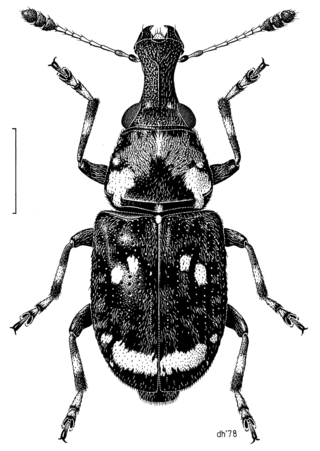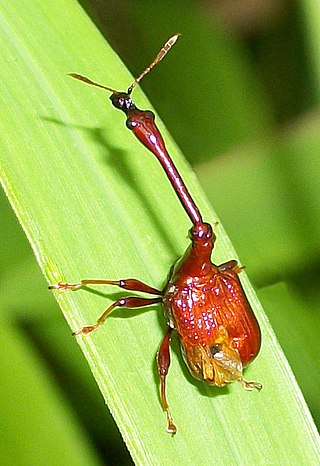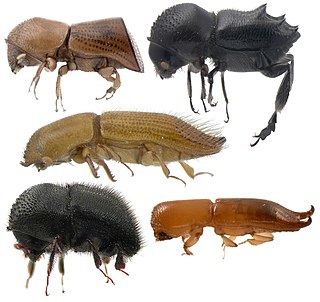
The Curculionidae are a family of weevils, commonly called snout beetles or true weevils. They are one of the largest animal families with 6,800 genera and 83,000 species described worldwide. They are the sister group to the family Brentidae.

Weevils are beetles belonging to the superfamily Curculionoidea, known for their elongated snouts. They are usually small – less than 6 mm in length – and herbivorous. Approximately 97,000 species of weevils are known. They belong to several families, with most of them in the family Curculionidae. It also includes bark beetles, which while morphologically dissimilar to other weevils in lacking the distinctive snout, is a subfamily of Curculionidae. Some other beetles, although not closely related, bear the name "weevil", such as the biscuit weevil, which belongs to the family Ptinidae.
Ambrosia beetles are beetles of the weevil subfamilies Scolytinae and Platypodinae, which live in nutritional symbiosis with ambrosia fungi. The beetles excavate tunnels in dead or stressed trees into which they introduce fungal gardens, their sole source of nutrition. After landing on a suitable tree, an ambrosia beetle excavates a tunnel in which it releases its fungal symbiont. The fungus penetrates the plant's xylem tissue, extracts nutrients from it, and concentrates the nutrients on and near the surface of the beetle gallery. Ambrosia fungi are typically poor wood degraders, and instead utilize less demanding nutrients. Symbiotic fungi produce and detoxify ethanol, which is an attractant for ambrosia beetles and likely prevents growth of antagonistic pathogens and selects for other beneficial symbionts. The majority of ambrosia beetles colonize xylem of recently dead trees, but some colonize stressed trees that are still alive, and a few species attack healthy trees. Species differ in their preference for different parts of trees, different stages of deterioration, and in the shape of their tunnels ("galleries"). However, the majority of ambrosia beetles are not specialized to any taxonomic group of hosts, unlike most phytophagous organisms including the closely related bark beetles. One species of ambrosia beetle, Austroplatypus incompertus exhibits eusociality, one of the few organisms outside of Hymenoptera and Isoptera to do so.

A woodworm is the wood-eating larva of many species of beetle. It is also a generic description given to the infestation of a wooden item by these larvae.

The bean weevils or seed beetles are a subfamily (Bruchinae) of beetles, now placed in the family Chrysomelidae, though they have historically been treated as a separate family. They are granivores, and typically infest various kinds of seeds or beans, living most of their lives inside a single seed. The subfamily includes about 1,650 species and are found worldwide.

A bark beetle is the common name for the subfamily of beetles Scolytinae. Previously, this was considered a distinct family (Scolytidae), but is now understood to be a specialized clade of the "true weevil" family (Curculionidae). Although the term "bark beetle" refers to the fact that many species feed in the inner bark (phloem) layer of trees, the subfamily also has many species with other lifestyles, including some that bore into wood, feed in fruit and seeds, or tunnel into herbaceous plants. Well-known species are members of the type genus Scolytus, namely the European elm bark beetle S. multistriatus and the large elm bark beetle S. scolytus, which like the American elm bark beetle Hylurgopinus rufipes, transmit Dutch elm disease fungi (Ophiostoma). The mountain pine beetle Dendroctonus ponderosae, southern pine beetle Dendroctonus frontalis, and their near relatives are major pests of conifer forests in North America. A similarly aggressive species in Europe is the spruce ips Ips typographus. A tiny bark beetle, the coffee berry borer, Hypothenemus hampei is a major pest on coffee plantations around the world.
Platypus is the English common name of the Australian egg-laying mammal of action which in science language is called the Ornithorhynchus anatinus.

Belidae is a family of weevils, called belids or primitive weevils because they have straight antennae, unlike the "true weevils" or Curculionidae which have geniculate (elbowed) antennae. They are sometimes known as "cycad weevils", but this properly refers to a few species from the genera Parallocorynus and Rhopalotria.

The term mycangium is used in biology for special structures on the body of an animal that are adapted for the transport of symbiotic fungi. This is seen in many xylophagous insects, which apparently derive much of their nutrition from the digestion of various fungi that are growing amidst the wood fibers. In some cases, as in ambrosia beetles, the fungi are the sole food, and the excavations in the wood are simply to make a suitable microenvironment for the fungus to grow. In other cases, wood tissue is the main food, and fungi weaken the defense response from the host plant.

Brentidae, sometimes known as the primitive weevils, is a cosmopolitan family of primarily xylophagous beetles also known as straight-snouted weevils. The concept of this family has been expanded with the inclusion of three groups formerly placed in the Curculionidae; the subfamilies Apioninae, Cyladinae, and Nanophyinae, as well as the Ithycerinae, previously considered a separate family. They are most diverse in the tropics, but occur throughout the temperate regions of the world. They are among the families of weevils that have non-elbowed antennae, and tend to be elongate and flattened, though there are numerous exceptions.

Anthribidae is a family of beetles also known as fungus weevils. The antennae are not elbowed, may occasionally be longer than the body and thread-like, and can be the longest of any members of Curculionoidea. As in the Nemonychidae, the labrum appears as a separate segment to the clypeus, and the maxillary palps are long and projecting.

The Attelabidae is a widespread family of weevils. They are among the primitive weevils, because of their straight antennae, which are inserted near the base of the rostrum. The prothorax is much narrower than the base of the elytra on the abdomen. Attelabidae and the related family Rhynchitidae are known commonly as the leaf-rolling weevils. Rhynchitidae may be treated as subfamily Rhynchitinae of the Attelabidae.

Xyleborini are a tribe of ambrosia beetles, highly specialized weevils of the subfamily Scolytinae. Much of the ambrosia beetle fauna in Eurasia and the Americas consists of Xyleborini species. Some Xyleborini are notorious invasive species.

Baridinae is a subfamily of true weevils (Curculionidae). It was established by Carl Johan Schönherr in 1836. Some 4,300 species in 550 genera are placed here, most of which occur in the New World. A few are economically significant pests, while others are in turn used for biocontrol of invasive plant pests. This subfamily also contains a few endangered species.

Austroplatypus incompertus, a type of ambrosia beetle, is endemic to Australia. They are found in the mesic forests, and subtropical and tropical ecosystems along the east coast of Australia. There are many unique characteristics attributable to the A. incompertus, like their gallery excavation in several Eucalyptus species, their obligate eusocial behavior, their relationship with fungi, and their unique sexual dimorphism. These beetles are one of the only insects that display obligate eusocial behavior. Additionally, their sexually dimorphic traits are of interest, since body size is reversed with males having smaller torsos than female a.incompertus beetles.

Ips is a genus of beetles in the family Curculionidae, the true weevils. They are bark beetles, members of the subfamily Scolytinae. Species are distributed throughout the Northern Hemisphere. Some are known as introduced species in Australia and Africa. Many species are pests of forest trees, especially pines and spruces. They are known commonly as engraver beetles, ips engraver beetles, and pine engravers.

Euplatypus is a genus of pinhole borers in the subfamily Platypodinae of weevils Curculionidae. There are at least 50 described species in Euplatypus.

Euplatypus compositus is a species of pinhole borer in the family of beetles known as Curculionidae. It is found in the southeastern United States. The beetle is associated with at least four species of Raffaelea fungi.
Euplatypus parallelus, previously known as Platypus parallelus, is a species of ambrosia beetle in the weevil family Curculionidae. The adults and larvae form galleries in various species of tree and logs. It is native to Central and South America but has spread globally, is present in Africa and is well established in tropical Asia.
Crossotarsus saundersi, commonly known as stem borer, is a species of weevil found in Sri Lanka, Australia and New Zealand.
















